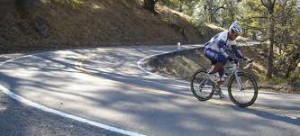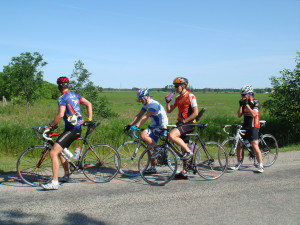Whether you’re riding on your own or in a group, there is a set of rules you should follow as a courtesy to everyone you share the road or path with. This post is a reminder for the veteran cyclists and a mini-lesson for newer ones.
Relaxed and Steady Riding
This courtesy suggestion is three fold. Not only do you need to keep your speed and line steady, but you also need to keep arms relaxed and off the aero bar to avoid wobbling, and ultimately, crashing. (The only exceptions for the aero bar are if you are leading the pack and pulling or solo riding, otherwise, use the grips!) If you need to move to the front, maintain a steady speed; don’t accelerate! Don’t bounce around as this can cause nervous energy among your group. In addition to speed, the pressure you put on your pedals should also be steady regardless of whether you are going up or down steep inclines, battling or leveraging winds, or excessively using brakes. (If you must use your brakes, gently do so in short, quick tugs of the front and pedal against the resistance. By doing it this way, you can moderate speed without scaring your rear group mates.
Never Overlap Wheels
If you have this bad habit, now is the time to break it! You’ll save yourself some group loathing and road rash if you do. When two tires rub, someone is going to get hurt. It only takes one person in front of you to move over a couple inches and unknowingly tapping your front wheel. This usually happens when someone zones out or fixates on something else. Pay attention and consume an energy gel if you need it to snap you back into cycling mode.
Changing Positions
It is common for beginner rides to stop pedaling just before pulling off the front. If you do this, it will cause a pile-up of slowdowns along the whole group. As mentioned above, keep a steady pressure on the pedals until you have cleared the front. Once you’ve pulled off, soft pedal and let your group mates pull through, only applying more pressure to effortlessly take your spot at the rear. Be sure to time it well or a gap will open up and you’ll be playing catch up. A suggested method to return to the line is to ease the bike sideways before your body. In doing this, you will have the chance to pull back if necessary to avoid collision. But if the bike moves in correctly, follow through by leaning your body over as well.
Incline and Decline
If you need to stand in order to climb up a hill, shift up a gear to compensate for a slower rhythm, keeping steady pressure on your pedals. Not only is this considerate for your rear wheel brothers who might end up riding your butt, it also gives you stability. When you change to a sitting position, do the opposite; downshift, and then keep steady pressure on pedals to maintain constant speed.

When navigating down a decline, your actions should be determined by your position in the group. Leaders need to keep pedaling to compensate for wind resistance, and rear riders should back off a few lengths to fend off drafting acceleration. If you happen to be a middle man (or woman), you’ll need to sit up, use light breaking or the wind for resistance, and keep pedaling to help maintain spacing and cool down legs from the last major incline they conquered.
Ooze Predictability
This suggestion is a biggie, and all the rest we mention below piggy back off of it. When people know what to expect from you they can act and react accordingly. While you might be aiming for style by riding smoothly and efficiently, it’s also a matter of survival. If you can’t keep steady and don’t maintain predictability in every facet of riding (changing positions, following traffic laws, etc…) you are putting you and any riding partners in a dangerous situation. While your riding fellows may not admit to the amount of stress your actions are causing, drivers are sure to. Cyclists won’t be taken seriously or be safe if they don’t ride responsibly.
Signal
This one doubles back to predictability. Signaling let’s your whole group know what you intend to do. Make sure to make eye contact with oncoming traffic when you reach intersections or places you need to merge. Stick your right or left arms out depending on which way you intend to turn. The whole bent arm signal is inefficient and has been shown to confuse vehicle drivers. If you are part of a large group, use your voice along with arm signals.
Broadcast Hazards to Your Pack-mates
The lead wheel brother is responsible for keeping everyone safe, so announcing potholes, rocks, traffic issues, or other problems you foresee is vital to everyone’s safety. Don’t be afraid to be vocal; make sure they know when slowing, stopping, turning or any other actions are going to take place to keep the group suave and cautious. If you’re not in the lead position, it’s still your job to relay the information you’re given further back in the group. Also, if problems are coming from a side or rear approach, it’s important that the eyes and ears send the message forward. Every person in the group needs to keep communication open for the good of all.
When Separated
At intersections it’s common that the group can get split in two. If this should happen, the lead group should soft pedal until the stragglers catch up again. On the other hand, if you happen to be the one that gets stuck a red light, stop! Running the red light to stay together isn’t worth the risk of injury or raging traffic reactions.
If you happen to be biking on trails or in areas without intersections it’s wise to preplan certain points on your route for breaks. If you do this, it can give any one that needs to regain his or her strength or energy time to return to the group.
It’s important that everyone is riding cohesively to stay safe and enjoy the route. We hope you found these helpful and will put them into practice if you aren’t already. Are there any other courtesies during a group ride you’d like to mention? Please tell us in the comments below!

